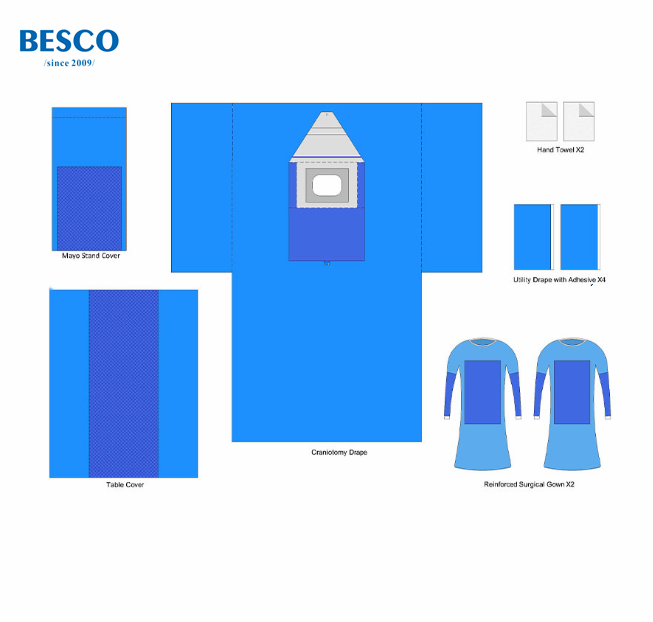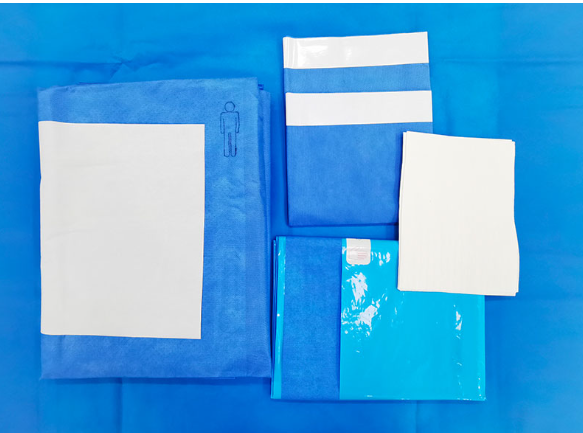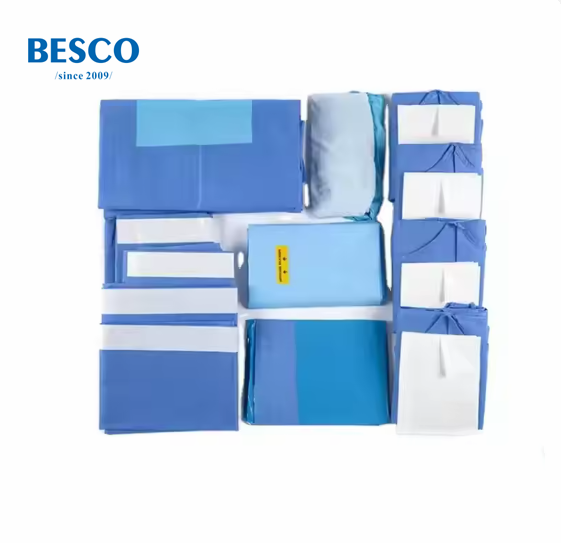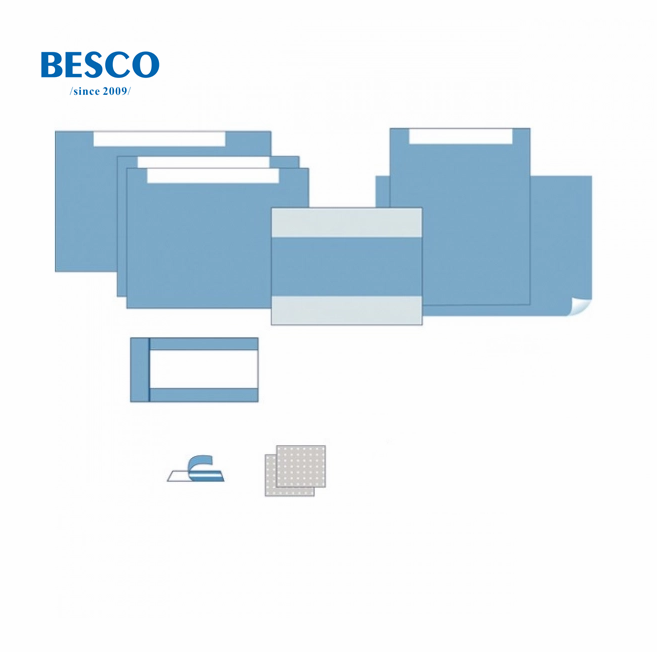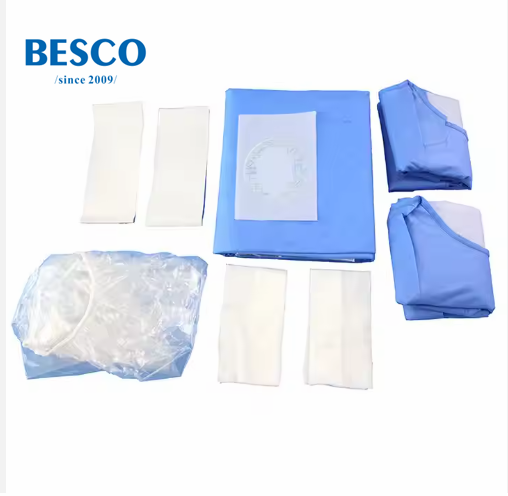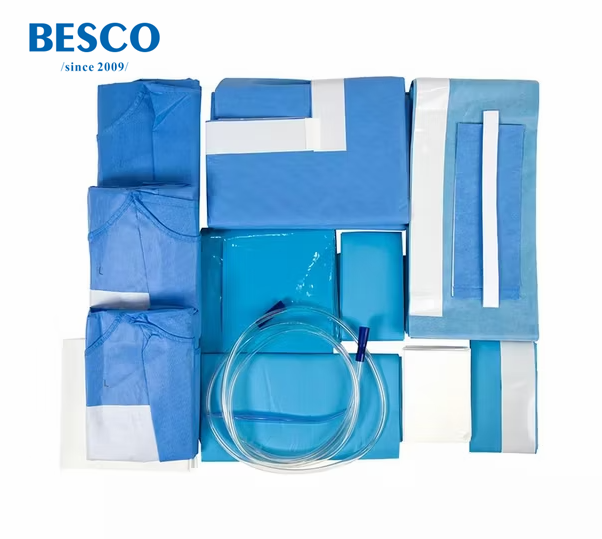| Name: | Neurology Surgical Packs |
|---|---|
| Model No.: | Neurology Surgical Packs |
| Material: | SMS |
| Brand: | BESCO |
| Keywords: | Neurology Surgical Packs,Neuro Surgery Drape Packs,Craniotomy Surgical Packs |
| MOQ: | 100 PACKS |
| Sample: | Available |
| LEAD TIME: | 5 days |
| Price: | US15.5 |
| Payment Term: | T/T in advance |
| Country of Original: | China |
| Port of Loading: | Qingdao |
| Factory Address: | Changyuan,China |
| Office: | Zhengzhou,China |
Products Description
BESCO offers an exceptional range of Neurosurgery & Craniotomy Surgical Packs.
The Neurology Surgical Packs contains all the surgical items needed for draping the patient.
This Neurology Surgical Pack is designed from the excellent material and latest techniques following the set norms of the market.
This Neurology Surgical Pack is in an amazing quality !
Features:
1.Isolation:isolating contaminated areas from operating areas.
2.Barrier:preventing fluid and microbial penetration.
3.Fluid Control: collecting body fluid and irrigation fluids.
4.Comfortable: light gram, soft, breathable.
5.Soft, lint free, light weight, compact moisture resistant, nonirritating, and static free.
Item | Neuro Surgical Packs | |||
Specification | Name | Size | QTY | Material |
Craniotomy Drape | 250×260cm | 1 | SMS+Absorbent area | |
Mayo Stand Cover | 145×75cm | 1 | PE+Hydrophilic PP | |
Back Table Cover | 140×190cm | 1 | PE+SMS | |
Hand Towel | 30×40cm | 2 | Woodpulp | |
Utility Drape with adhesive tape | 75×50cm | 2 | SMS | |
All the specification and contents can be customized | ||||
Material | SMS,SSMMS, PE+PP,PE+SMS, PE+Hydrophilic PP etc | |||
Sterile | EO(Ethylene Oxide) | |||
Package | Sterile Pouch, 10 packs/carton, carton size: 60*40*50cm | |||
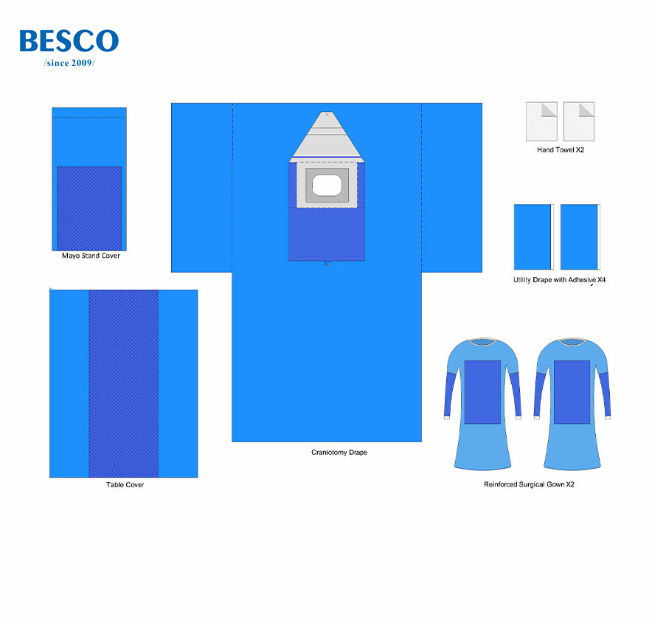 Neurology Surgical Packs.png"/>
Neurology Surgical Packs.png"/>
Neurology surgical packs are specialized collections of medical instruments and supplies used during neurosurgical procedures. These packs are designed to streamline the surgical process and ensure that all necessary tools are readily available.
Components of Neurology Surgical Packs:
Instruments: Commonly include scalpels, forceps, scissors, and retractors specifically designed for neurosurgery.
Supplies: May contain drapes, sponges, sutures, and sterile gloves.
Customization: Packs can be tailored to specific procedures, such as craniotomies or spinal surgeries.
Purpose:
Efficiency: Pre-packaged sets reduce preparation time and minimize the risk of missing essential tools.
Sterility: Ensures that all instruments are sterile and ready for use, which is critical in surgical settings.
Usage:
Utilized by neurosurgeons and surgical teams in hospitals and surgical centers.
Often prepared by surgical supply companies or hospital sterile processing departments.
These packs enhance the organization and safety of neurosurgical operations, contributing to better patient outcomes.
Neurological surgical packs contain specialized instruments and drapes for procedures involving the brain, spinal cord, and nervous system. Proper use involves sterile technique, including opening the pack carefully and using the instruments according to their intended purpose and manufacturer instructions. Specific procedures will dictate the exact instruments and drapes needed, with some packs featuring specialized tools for navigation or nerve monitoring.
General Steps for Using a Neurosurgical Pack:
1. Preparation:
Ensure the surgical area is prepared, including patient positioning and skin preparation.
2. Opening the Pack:
Open the pack using sterile technique, keeping the contents sterile and avoiding contamination. This typically involves unfolding the outer wrap and then unfolding the inner sterile drapes.
3. Instrument Selection:
Identify and select the appropriate instruments from the pack based on the specific surgical procedure. This may involve using specialized tools for craniotomy, spinal surgery, or nerve monitoring.
4. Drape Application:
Apply the drapes, ensuring they are properly positioned and secured to create a sterile field around the surgical site.
5. Instrument Use:
Use the instruments according to standard neurosurgical techniques and the manufacturer's instructions. This may include using navigation systems, nerve stimulators, or microinstruments.
6. Post-Procedure:
Properly disassemble and clean instruments according to the manufacturer's IFU (Instructions for Use) and prepare them for sterilization.
Key Considerations:
Sterile Technique:
Maintaining a sterile field is crucial to prevent infection. This includes proper hand hygiene, gowning, gloving, and careful handling of instruments.
Navigation:
Some procedures may require the use of neuronavigation systems, which require registration of the surgical instruments and reference frames.
Nerve Monitoring:
In procedures involving delicate nerves, nerve monitoring equipment may be included in the pack, requiring careful setup and use.
Manufacturer Instructions:
Always refer to the specific manufacturer's instructions for each instrument and drape included in the pack.
"Neurology surgical packs" likely refers to sterile drapes, instruments, and equipment specifically designed for neurosurgical procedures, such as a craniotomy. To use them, you would first prepare the patient and the surgical site, then apply the draping by removing the release liner and positioning the pouch towards the floor. Next, you would follow directional arrows to open the drape, exposing the adhesive film. The process involves opening the large pouch for suction and utilizing tabs for cable management. Each pack contains specialized instruments like drills for burr holes, retractors, rongeurs, and forceps for bone and tissue manipulation, all designed for use in cranial and spinal surgeries.
Preparation and Draping
Patient Preparation: Anesthesia is administered, and the patient is positioned to allow optimal access to the surgical site.
Surgical Site Preparation: The surgical area is prepped according to sterile protocols.
Apply the Draping:
Remove the Release Liner: Pull the protective film off the adhesive to expose the sticky surface.
Position the Pouch: Ensure the pouch is positioned towards the floor.
Open the Drape: Follow the directional arrows to open the drape to the sides.
Secure the Drape: The exposed adhesive film secures the drape in place.
Manage Cables: Use the tabs on the drape for managing cables or other instruments.
Instrument Use
1. Burr Hole Creation:
Use a surgical drill to create burr holes in the skull, being careful to drill at a 90-degree angle and avoid the inner table of the skull to prevent injury to the brain.
2. Bone and Tissue Manipulation:
Use a surgical saw to cut the bone.
Apply forceps to remove any bone dust or chips.
Employ rongeurs to create windows within the bone.
Use hooks and probes to manipulate tissues and explore around the spine.
Use holding and retraction instruments to expose and stabilize the surgical area.
Post-Procedure and Cleaning
Inspection: Carefully inspect instruments for cleanliness and damage.
Cleaning: Cleanse instruments using validated washer-disinfector machines with low-foaming, neutral-pH cleaning solutions.
Disposal: Dispose of used materials, including the tissue retrieval bag and specimens, according to facility protocols.
